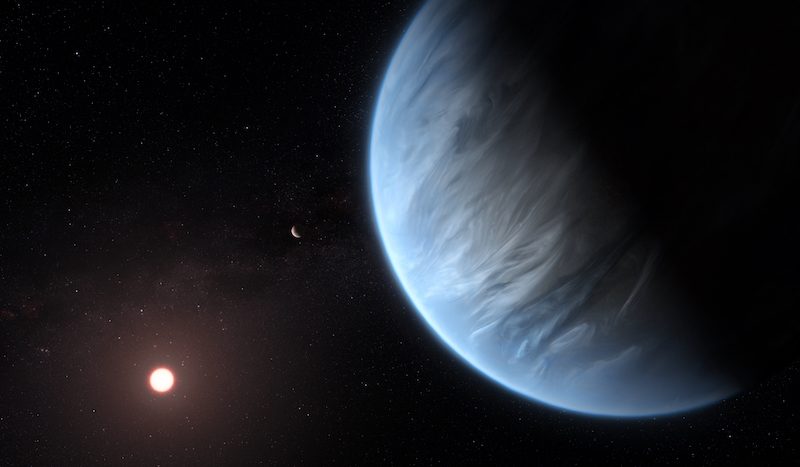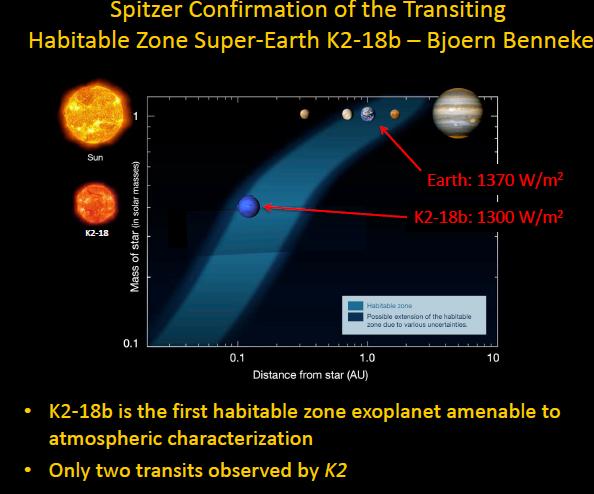
UPDATE: Since this story was published on Wednesday, there’s been a firestorm of controversy about it. We’ve got a follow-up coming on Sunday. Read this one first …
Scientists announced another exciting discovery today (September 11, 2019) regarding potentially habitable exoplanets. For the first time, they’ve detected water vapor in the atmosphere of a distant super-Earth – called K2-18b – orbiting its star in the habitable zone. The word “habitable” in this context doesn’t mean humans could live there. A star’s habitable zone is the zone where liquid water might exist, and water is essential for life as we know it. This particular exoplanet also has relatively moderate temperatures, by earthly standards. With confirmed water vapor and habitable temperatures, K2-18b has just become a very intriguing target in the search for life.
The peer-reviewed discovery was published in a paper today (September 11, 2019) in Nature Astronomy, by researchers from University College London (UCL). Another paper (draft version) was also published on ArXiv on September 10, 2019.
The new work stems from observations made with the Hubble Space Telescope. It marks the first overall successful atmospheric analysis of an exoplanet in the habitable zone of its star. Such studies have proven difficult due to the distances of these worlds and their smaller sizes as compared to gas giants like Jupiter.
Water has been discovered in the atmosphere of a "super-Earth" exoplanet orbiting its star within the habitable zone. While the exoplanet's atmosphere isn't expected to be "habitable" by human standards, this is a remarkable discovery: https://t.co/CzkgUzdnPp pic.twitter.com/wqkABFnJ00
— Ian O'Neill (@astroengine) September 11, 2019
According to Angelos Tsiaras at the UCL’s Centre for Space Exochemistry Data (CSED) and first author of the new paper:
Finding water in a potentially habitable world other than Earth is incredibly exciting. K2-18b is not ‘Earth 2.0’ as it is significantly heavier and has a different atmospheric composition. However, it brings us closer to answering the fundamental question: Is the Earth unique?
The analysis of K2-18b’s atmosphere was based on data from the Hubble Space Telescope. In this analysis, the scientists also found atmospheric hydrogen and helium. They believe nitrogen and methane might also be present, but further studies are needed to confirm that, or not. Scientists also need to figure out how cloudy the atmosphere is and how much water vapor there is, percentage-wise. They also think it’s likely that there are water clouds in K2-18b’s atmosphere as well, and possibly even rain. From the second paper:
Given the relatively low irradiation by the star, K2-18b’s temperature is low enough that the detected water vapor can plausibly condense to form liquid droplets. It is therefore possible that liquid water rain precipitates in the mid-atmosphere of K2-18b.
Co-author Giovanna Tinetti said:
Our discovery makes K2-18b one of the most interesting targets for future study. Over 4,000 exoplanets have been detected but we don’t know much about their composition and nature. By observing a large sample of planets, we hope to reveal secrets about their chemistry, formation and evolution.
As Tsiaras added:
This study contributes to our understanding of habitable worlds beyond our solar system and marks a new era in exoplanet research, crucial to ultimately place the Earth, our only home, into the greater picture of the cosmos.

As I mentioned, K2-18b is a super-Earth, a planet larger than Earth but smaller than Neptune. It orbits the red dwarf star K2-18 every 33 days, and is 110 light-years away in the direction of the constellation Leo the Lion. NASA’s Kepler Space Telescope discovered this world in 2015. The actual conditions on the surface of the planet still aren’t known, but its red dwarf star is quite active, meaning that the planet is exposed to ultraviolet radiation that red dwarfs are famous for. However, current studies suggest that K2-18b receives about the same amount of radiation from its star as Earth does from the sun. That would be a good thing for the possibility of life. Still, there are many unknowns when it comes to other factors affecting possible habitability for this world.
A previous study said that the planet is probably either a mostly rocky planet with a small gaseous atmosphere – like Earth, but bigger – or a mostly water planet with a thick layer of ice on top of it. According to Ryan Cloutier, a Ph.D. student in the Université de Montréal Institute for Research on Exoplanets (iREx):
With the current data, we can’t distinguish between those two possibilities. But with the James Webb Space Telescope we can probe the atmosphere and see whether it has an extensive atmosphere or it’s a planet covered in water.
The Webb telescope will also have the capability of analyzing K2-18b’s atmosphere for possible biosignatures, in this case gases like oxygen or methane, that could indicate not just the possibility, but the presence of life. False positives would need to ruled out, however, as both of those gases can also be created without life being involved.
K2-18 also has another super-Earth, K2-18c, but that planet is closer to the star and not likely to be in the habitable zone. It was discovered by Cloutier in 2017.

Kepler and other telescopes have been finding exoplanets by the thousands in recent years, and many of those are super-Earths, like K2-18b. Scientists expect that many more exoplanets will continue to be discovered, some of which will be potentially habitable. As co-author Ingo Waldmann noted:
With so many new super-Earths expected to be found over the next couple of decades, it is likely that this is the first discovery of many potentially habitable planets. This is not only because super-Earths like K2-18b are the most common planets in our galaxy, but also because red dwarfs – stars smaller than our sun – are the most common stars.
For the first time, researchers using Hubble have detected water vapor signatures in the atmosphere of a planet beyond our solar system that resides in the "habitable zone." For more information: https://t.co/vUa2NbkbwU pic.twitter.com/ey3uz2ynMk
— Hubble (@NASAHubble) September 11, 2019
Bottom line: The discovery of water vapor in the atmosphere of K2-18b is the first time that water has been found on a potentially habitable super-Earth exoplanet.
Source: Water Vapour in the Atmosphere of the Habitable-Zone Eight Earth-Mass Planet K2-18 b











